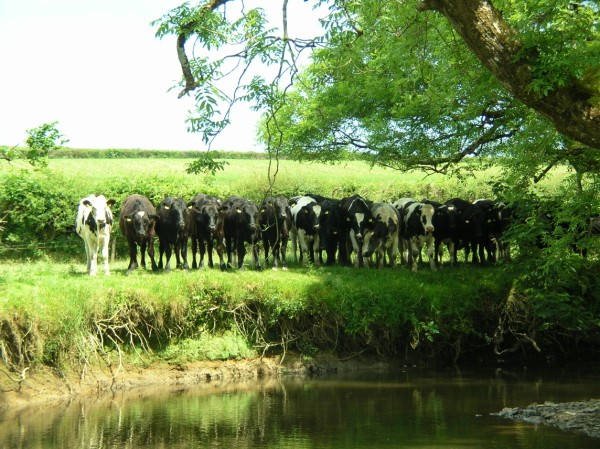Welcome To Julians Farm
 Nestled along the River Torridge in West Putford, Julians is a 200-acre working beef farm that blends rich history, sustainable practices, and educational outreach.
Nestled along the River Torridge in West Putford, Julians is a 200-acre working beef farm that blends rich history, sustainable practices, and educational outreach.
The land includes Culm grassland, river frontage, established and newly planted woodlands, and a rare Neolithic Longbarrow, one of only two in Devon, and a scheduled English Heritage monument.
Farming Today
Our current system focuses on rearing high-quality British Blue cross calves, purchased at just one week old and raised on the farm until around 20–24 months. These animals are then sold at market as Forward Stores, often topping the market with our best stock.
We grow our own silage and hay to feed the cattle over winter and take pride in using traditional, sustainable practices. Silage-making typically begins in early June, weather permitting, with hay produced when longer dry spells allow.
The farm operates with a core range of machinery and brings in contractors during peak seasons such as silage and baling. In addition to cattle, we occasionally rear pigs, usually Saddleback cross Gloucester Old Spot, which are fed a special porridge mix and kept for around three months.
Stewardship and Sustainability
Since joining the Higher Level Stewardship scheme in 2014, we've restored our Culm grassland by clearing scrub and installing fencing to promote biodiversity and make the land grazable once again. In partnership with the Woodland Trust, we planted over 1,100 native trees in 2013 on two steep fields adjacent to a stream feeding the River Torridge, enhancing both habitat and landscape resilience.
Education and Care Farming
We’re proud to offer structured educational visits for primary and secondary schools, giving children hands-on experiences in farming, nature, and rural history. We’re also a registered Care Farm, running weekly sessions with students from Holsworthy and Okehampton Community Colleges. These students help care for our calves and learn about the wider farming ecosystem through partnerships with organisations such as Penbode Vets, Smallridge Bros, Devon Wildlife Trust, and others.
Wildlife and Nature
The farm is alive with wildlife. You may spot white doves nesting in the barn rafters, hear owls calling at night, or see rabbits, foxes, and even deer, including fallow and the occasional red deer. Birds of prey like buzzards and hawks are a common sight across our fields.
Traditional Buildings
The main farmyard features a courtyard of red brick and stone barns, dating back to 1886 when Mark Rolle owned the estate. These traditional buildings are used for workshops, storage, and rearing calves. Modern structures, like the cow cubicle building and hay shed, provide winter housing and fodder storage. At the front of the farm stands the original Pig Court, a charming building with five arched doors and a cobbled courtyard.
A Farm with Deep Roots
Julians has been in the Guy family for four generations. Andrew and Jenni continue the legacy begun by Andrew’s father, John Guy, who took over the farm in 1954. Before the Guy family, the farm belonged to Mark Rolle of the Stevenstone Estate. Historical records trace the site back to the Domesday Book of 1086, where it was listed as a manor named Pudeforda.
In the past, the farm relied on teams of heavy horses and employed up to six workers. While much has changed with modern machinery, the field names and boundaries remain the same, preserving the connection between past and present.
